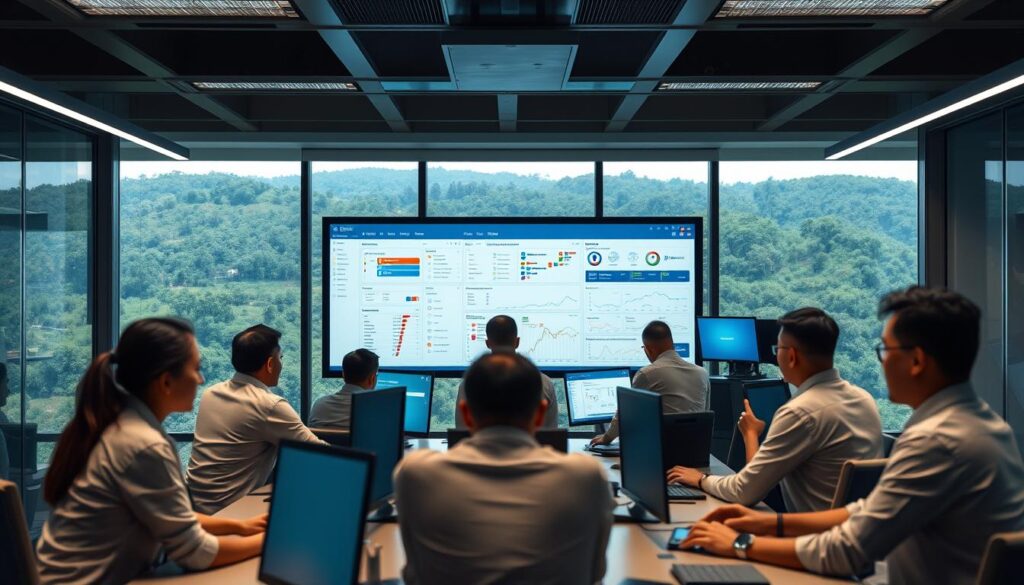Ever wondered how some businesses handle many tasks at once while others lag behind? It’s all about the tech behind real-time task management. This piece dives into how top-notch Task & Field Force Management can change the game for SMEs in the Philippines.
By using the latest SME tools and software, companies can make their workflows smoother. This leads to better communication and more productivity. These systems also make field force management more transparent and organized.
For real tips on how to get started, check out
Key Takeaways
- Real-time task assignment improves workflow efficiency for SMEs.
- Effective field force management relies on strong communication.
- Integrating software solutions is critical for optimal task management.
- Collaboration tools enhance transparency and accountability.
- Data analytics helps assess KPIs to improve task performance.
- Best practices in task assignment can lead to significant productivity boosts.
Introduction to Real-Time Task Assignment and Monitoring
Real-time task assignment and monitoring are key to better work efficiency, mainly in fast-paced settings like businesses in the Philippines. It means tasks are given out right away and watched closely. This way, companies can tackle problems fast, making sure tasks are done on time and up to standard.
Productivity tools are vital for this process. They help teams work together smoothly. With clear task assignments, teams can do their jobs well without any hitches. This approach helps businesses adjust quickly to new situations, using their resources better and boosting productivity.
The Importance of Effective Communication in Task Management
Effective communication is key to managing tasks well. It makes sure everyone knows what they need to do. This helps the team work together towards common goals.
Open dialogue helps teams solve problems fast and together. Using the right tools makes tracking progress and sharing updates easy. These tools fit into daily work, making everything clear and accountable.

Good communication also makes team members happier. Here are some big benefits:
- Increased clarity in roles, which minimizes confusion.
- Boosted collaboration, leading to enhanced problem-solving.
- More effective feedback loops that enhance performance.
Regular meetings and updates keep everyone informed. These steps are crucial for managing tasks well. They make sure everyone can do their best work.
| Benefit | Description | Outcome |
|---|---|---|
| Clarity | Clear instructions and roles reduce ambiguity. | Improved task execution. |
| Collaboration | Frequent communication encourages teamwork. | Better problem resolution. |
| Feedback | Timely input allows for adjustments. | Enhanced performance over time. |
Key Components of Real-Time Monitoring Systems
Real-time monitoring systems are key for managing tasks well in many fields. They have important parts that help work smoothly. One big part is how they collect data. This data comes from many places, giving a full view of what’s happening.
Another key part is setting performance metrics. These metrics help teams see how well they’re doing. They act as goals to aim for. With these systems, teams can keep track of their progress and make changes fast if needed.
The tech behind real-time analytics is also crucial. Strong software can handle data quickly. This helps managers make smart choices fast. Using these systems makes teams more accountable and leads to better results.
Utilizing Software Tools for Efficient Task Assignment
Using the right software can really boost productivity for small and medium-sized enterprises (SMEs) in the Philippines. These tools make assigning tasks easier, helping teams work better together. Tools like Asana, Trello, and Zenzap show how important features like task prioritization and teamwork are.
Overview of Popular Task Management Tools
There are many task management tools out there, each with its own strengths. Let’s look at three well-known ones:
| Tool | Key Features | User Rating |
|---|---|---|
| Asana | Task prioritization, project tracking, team collaboration | 4.5/5 |
| Trello | Kanban boards, drag-and-drop interface, customizable workflows | 4.7/5 |
| Zenzap | Real-time collaboration, task reminders, mobile accessibility | 4.6/5 |
Integration Capabilities with Existing Infrastructure
How well a software tool works depends on how well it fits with what you already use. Tools that work well with other apps and systems make things smoother. This makes teams more efficient and helps businesses manage tasks better.

The Role of Data Analytics in Task Performance
Data analytics is key to boosting task performance in companies. It helps evaluate projects and spot areas for betterment. Knowing how to use these insights leads to smarter decisions and more efficient work.
It’s important to pick the right key performance indicators (KPIs) to measure success. KPIs give clear numbers to check how tasks are doing and if goals are met. The right KPIs should match the company’s goals for best results.
Choosing the Right Key Performance Indicators (KPIs)
KPIs should be clear, measurable, achievable, relevant, and timely (SMART). This helps teams focus on what’s most important, making everyone accountable. Here are some KPIs that work well for small businesses:
- Task Completion Rate
- Time Taken for Task Completion
- Employee Productivity Levels
- Quality of Task Deliverables
- Feedback Scores from Stakeholders
Companies use data analytics tools to track these KPIs easily. For more on performance metrics, see this guide on KPIs and performance metrics. These tools help teams tweak their plans based on current data, making task management better.
Using data analytics helps leaders and empowers employees with insights on their work. It encourages teams to keep improving, making the workplace more engaging.
Task & Field Force Management: Optimizing Workforce Productivity
In today’s fast-paced world, managing field forces well is key to boosting productivity. Companies that use real-time task management systems can better use their resources. This cuts down on idle time for employees, leading to big gains in efficiency.
Using real-time data, supervisors can keep an eye on tasks as they happen. This keeps workers focused and responsible, building a sense of duty. Task optimization not only boosts individual performance but also the team’s overall productivity. By assigning tasks wisely, based on current workloads and skills, companies can run smoother and produce more.
Also, using structured task management systems improves team communication and teamwork. When everyone knows their role and deadlines, productivity goes up. This teamwork spirit drives the company forward, aiming for success together.

Real-Time Monitoring: Enhancing Operational Efficiency
Real-time monitoring is key to boosting efficiency in today’s fast world. It lets companies see what’s happening right now. This way, they can spot problems fast and fix them quickly.
Task monitoring helps businesses check how they’re doing. It keeps teams on track and improves talks between departments. When everyone knows what’s happening, making decisions gets easier and smarter.
Real-time monitoring brings many benefits:
- Increased Responsiveness: Problems get fixed fast, cutting down on lost time.
- Better Resource Management: It helps use resources wisely.
- Enhanced Productivity: Watching things closely can make teams work better.
Using real-time monitoring tools makes businesses more efficient. They can quickly adjust to new market needs.
| Benefit | Description |
|---|---|
| Immediate Insights | Real-time data helps spot problems right away. |
| Streamlined Workflows | Watching things closely keeps operations smooth. |
| Data-Driven Decisions | Good data leads to smart choices. |
| Enhanced Collaboration | Task monitoring boosts teamwork and communication. |
The Benefits of Collaborative Platforms for Task Monitoring
Collaborative platforms bring big benefits to task monitoring. They make it easier to see what’s happening with tasks and improve teamwork. These tools help everyone join in on project work.
When everyone can see task updates and assignments, it creates a transparent culture. This boosts team spirit and morale.
Impact on Team Dynamics and Morale
Collaborative platforms change how teams work together. They make sure everyone knows their part and can be held accountable. This makes everyone feel they belong and are part of something bigger.
It also means team members feel their work is valued. They know they’re part of a team that talks openly and solves problems together.
These platforms help teams give and get feedback right away. This makes relationships stronger. It also means conflicts get solved fast, keeping the work flow smooth.
| Benefits | Impact on Team Dynamics | Effect on Morale |
|---|---|---|
| Improved Task Visibility | Increases accountability among team members | Empowers individuals through recognition |
| Real-time Feedback | Encourages open communication and swift resolution of conflicts | Enhances a supportive work environment |
| Enhanced Collaboration | Strengthens relationships through shared goals | Boosts overall team morale and motivation |
Using collaborative platforms really helps teams work better together. It changes how they handle projects and interact with each other.
Challenges in Implementing Real-Time Task Assignment Systems
Setting up real-time task systems is tough for many businesses, like small and medium-sized enterprises (SMEs). One big problem is fitting new systems into old processes. Companies often find it hard to change their ways to use new task systems. This can cause confusion and lower productivity.
Another big challenge is getting people to accept change. Employees might be scared of new tech, worried it will mess up their routines. This fear can make them less happy and slower to use new ideas at work.
Lastly, dealing with too much data is a big issue. Real-time systems give a lot of info, but it’s hard to make sense of it all. Without the right training and tools, teams can get lost in the sea of data.
To overcome these hurdles, businesses can try a few things:
- Offer detailed training to show employees how the new system works and its benefits.
- Make changes slowly to help everyone adjust and reduce resistance.
- Use tools that help manage and analyze important data.
Best Practices for Real-Time Task Assignment and Monitoring
To make real-time task assignment and monitoring work well, you need a solid plan. Start by setting up your system right. This means choosing tools that fit your business needs.
Keeping your monitoring systems updated is key. This way, you avoid downtime and keep productivity high. Listening to what users say helps make your system better and meet your business goals.
Always look for ways to improve how you assign tasks. Training your team on new tools helps them work better together. Good communication makes everyone responsible and helps get tasks done faster.
| Best Practice | Description |
|---|---|
| Strategic Tool Selection | Choose tools that align with specific organizational needs for effective task assignment. |
| Routine Maintenance | Implement regular checks and upgrades to keep monitoring systems current and functional. |
| User Feedback Integration | Encourage input from users to continuously refine processes and enhance system performance. |
| Staff Training Sessions | Offer training workshops to familiarize employees with the latest tools and practices. |
| Clear Communication | Establish straightforward communication structures to promote transparency and accountability. |

Case Studies: Successful Implementation in Philippine SMEs
Looking at real examples of SMEs in the Philippines shows how well real-time task systems work. These businesses overcame many challenges. They found ways to make real-time monitoring and task management work for them.
Example 1: Company Implementation Success Story
A top logistics company in the Philippines had trouble managing deliveries. They used a real-time task system to fix this. This change made them much faster at answering customer questions and reduced delays.
They also gave their team mobile tools to work better. This led to a 30% boost in delivery speed and happier customers.
Example 2: Achieving Goals through Effective Monitoring
A manufacturing SME started using a detailed monitoring system. It let them watch production tasks live. This made their work flow better and showed what each team was doing.
By looking at how things were going and fixing problems fast, they cut production time by 25%. This shows how SMEs in the Philippines can really improve by watching their tasks closely.
Conclusion
Real-time task assignment and monitoring systems are key for small and medium enterprises (SMEs) in the Philippines. They help improve how work gets done. These tools make assigning tasks easier and help teams work together better.
Using these systems brings many benefits. It makes work more efficient and teamwork stronger. By using these tools, SMEs can stay ahead in the competitive market.
This move towards better task assignment and monitoring is not just about tech. It’s about making teams stronger and work environments better. This leads to better results for businesses.
FAQ
What is real-time task assignment and why is it important for SMEs?
Real-time task assignment means tasks are given and checked right away. It’s key for SMEs to boost productivity and tackle problems fast.
How can effective communication improve task management?
Good communication makes sure everyone knows their job. It helps teams work together towards goals. Using the right tools makes things clear and everyone accountable.
What are the key components of real-time monitoring systems?
Important parts are how data is collected, what metrics are used, and the tech for real-time analysis. These help make quick decisions and improve how things work.
Which software tools are recommended for efficient task assignment?
Tools like Asana, Trello, and Zenzap are great. They help with task order, team work, and are easy to use. They help SMEs manage tasks well.
How does data analytics contribute to task performance evaluation?
Data analytics helps pick the right KPIs to track progress. It makes decisions based on data, helping improve how things work.
What challenges might SMEs face when implementing real-time task assignment systems?
SMEs might struggle with integrating systems, getting used to new things, and too much data. It’s important to tackle these to run smoothly and effectively.
What best practices should SMEs adopt for real-time task assignment and monitoring?
SMEs should set up systems right, keep them running well, and always look to improve. This boosts efficiency and results.
Can you provide examples of successful real-time task assignment implementation in Philippine SMEs?
Yes, there are case studies of SMEs in the Philippines that did it well. They share their struggles, solutions, and successes, showing how it improves operations.
How do collaborative platforms affect team dynamics?
Platforms that help teams work together make everyone feel part of a community. It boosts morale and makes sure everyone is in the loop.